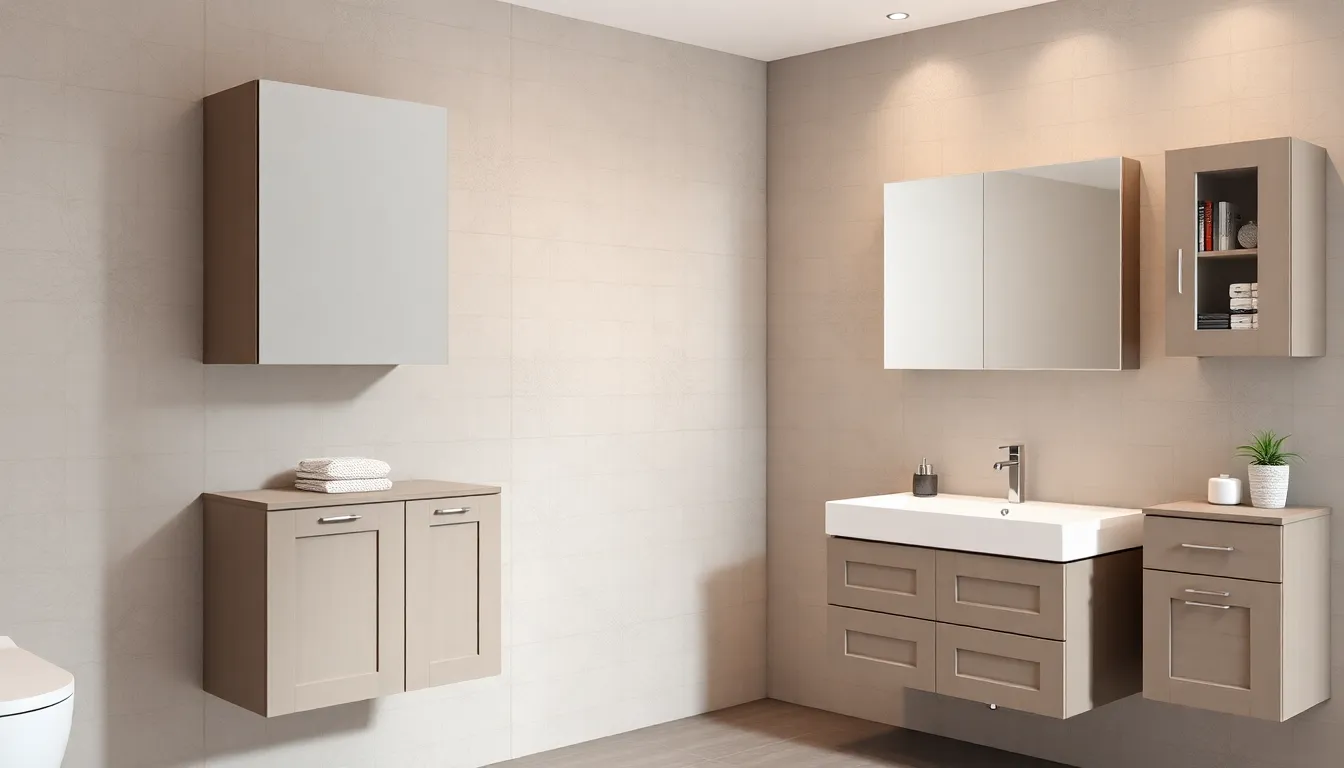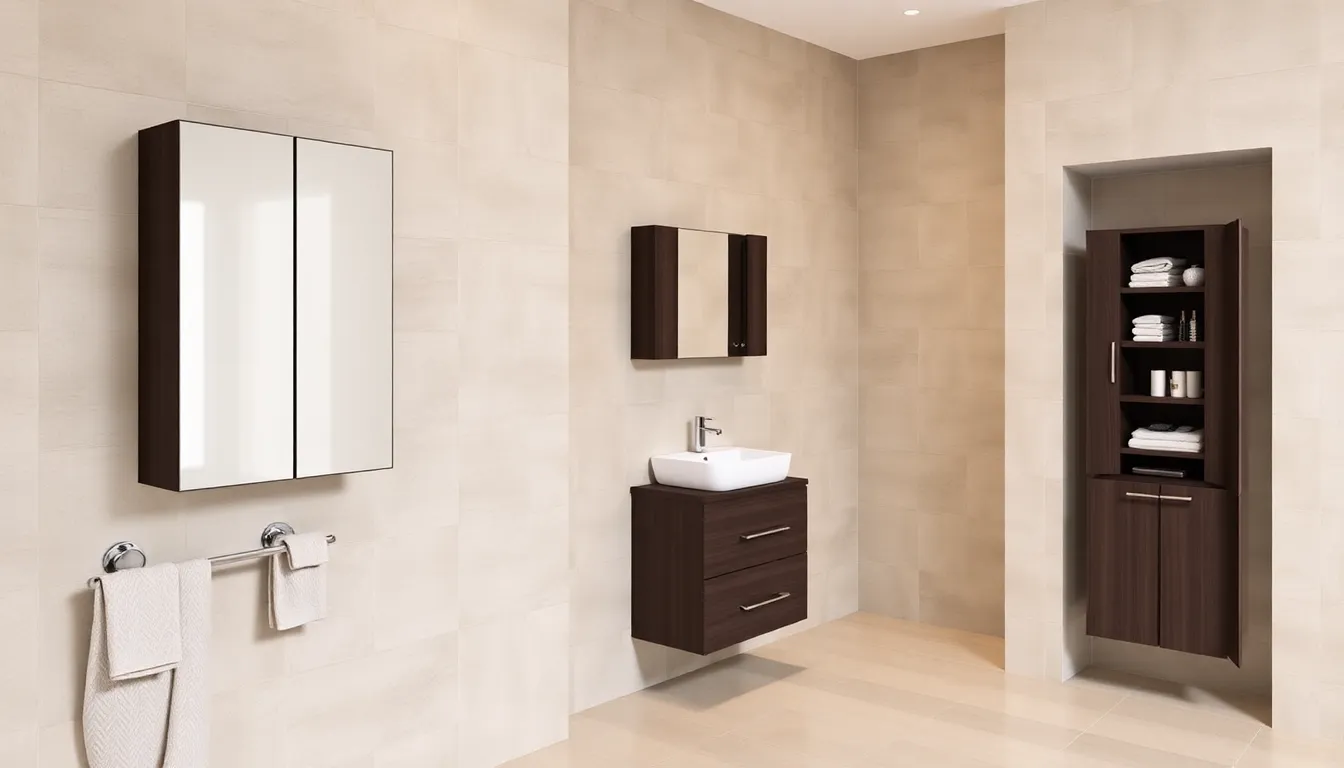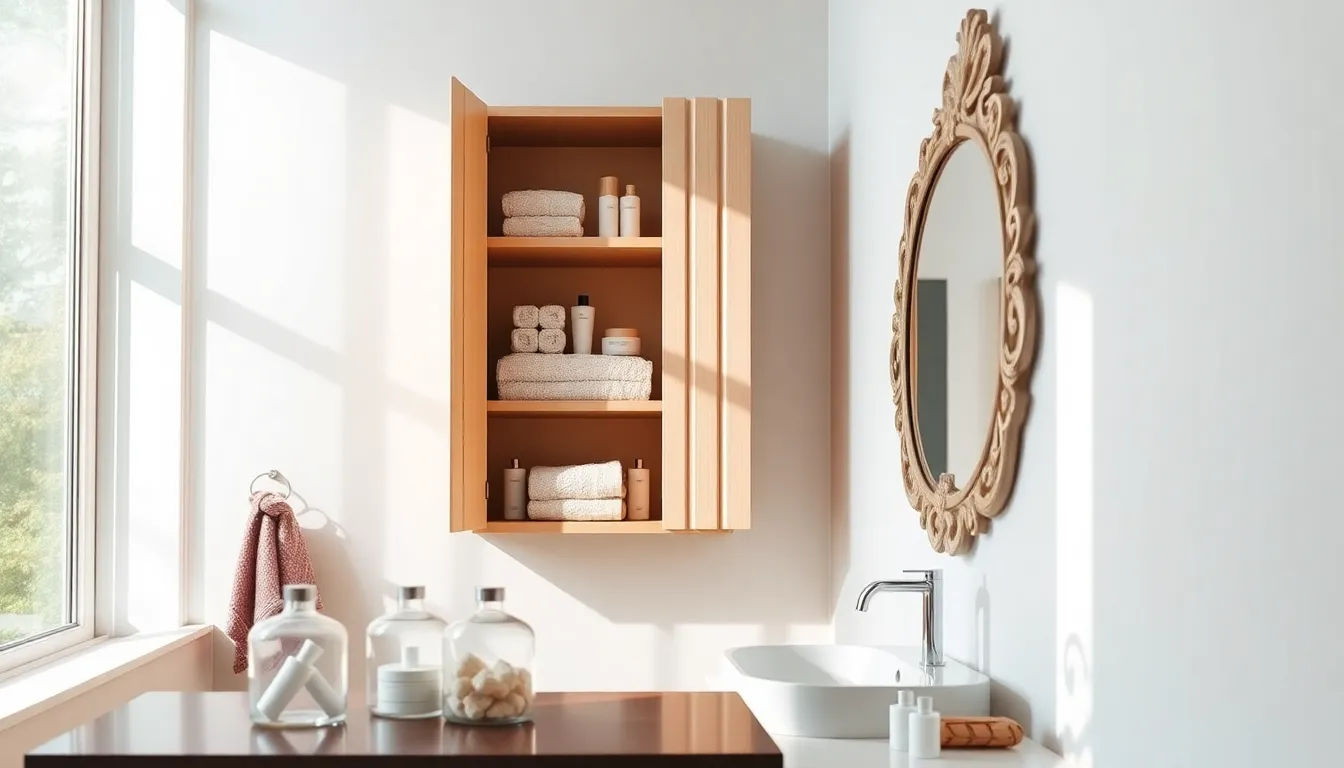In the hustle and bustle of daily life, a cluttered bathroom can quickly become a source of stress. Efficient bathroom cabinet storage not only maximizes space but also transforms the area into a serene retreat. With the right organization strategies, anyone can create a functional and stylish bathroom that meets their needs.
From sleek cabinetry to clever shelving solutions, the options for enhancing storage are endless. Whether it’s finding the perfect spot for toiletries or creating a designated space for towels, effective storage solutions can make a world of difference. This article explores innovative ideas and practical tips to help anyone optimize their bathroom cabinet storage, turning chaos into calm.
Table of Contents
ToggleOverview of Bathroom Cabinet Storage
Bathroom cabinet storage plays a crucial role in maintaining an organized and functional space. Efficient storage solutions not only reduce clutter but also enhance the overall aesthetics of the bathroom. Innovative designs incorporate modern cabinetry and smart shelving options, allowing ample storage without sacrificing style.
Key Benefits of Bathroom Cabinet Storage
- Maximized Space: Cabinets utilize vertical space, offering room for towels, toiletries, and cleaning supplies. Well-designed cabinets can fit into corners or under sinks, optimizing every inch of available space.
- Enhanced Organization: Built-in organizers, such as drawer dividers and pull-out shelves, contribute to a systematic approach to storage. This organization minimizes time spent searching for items, streamlining daily routines.
- Improved Aesthetics: Stylish cabinets complement bathroom decor, transforming the atmosphere. Sleek finishes and designer hardware elevate the visual appeal, making the bathroom a welcoming retreat.
- Increased Property Value: Well-planned storage solutions add functionality and allure, potentially increasing property value. A thoughtfully designed bathroom can attract future buyers, showcasing the importance of adequate storage.
- Customization Options: Modular cabinetry allows for personalization. Homeowners can choose sizes, colors, and finishes to suit their unique tastes and requirements.
Strategies for Effective Bathroom Cabinet Storage
- Evaluate Needs: Assess storage requirements based on the number of occupants and product types. Identify essential items needing access versus those suitable for long-term storage.
- Create Zones: Designate areas for specific categories, such as skincare, hair products, or cleaning supplies. This zoning enhances usability and keeps items conveniently located.
- Incorporate Vertical Solutions: Utilize wall-mounted cabinets or hanging shelves for added storage options. Vertical space often goes unused, offering an efficient way to store items off countertops.
- Implement Clear Containers: Use transparent bins or labeled baskets within cabinets for easy visibility. This method simplifies locating items and promotes a tidy appearance.
- Plan for Accessibility: Install cabinets at appropriate heights for easy access. Inclusion of pull-out or slide-out elements ensures even items at the back remain reachable.
By rethinking bathroom cabinet storage, homeowners can cultivate an organized, tranquil, and stylish environment that enhances their daily routines.
Types of Bathroom Cabinets


Various types of bathroom cabinets provide tailored storage solutions for different needs and spaces. Understanding these options helps in selecting the best fit for any bathroom.
Wall-Mounted Cabinets
Wall-mounted cabinets elevate storage space, especially in smaller bathrooms. These cabinets attach directly to the wall, freeing up floor space for other uses. Available in various sizes and designs, wall-mounted cabinets feature adjustable shelves for customizable storage. They often incorporate mirrored doors, enhancing both functionality and aesthetics.
Freestanding Cabinets
Freestanding cabinets offer versatility and easy installation. Positioned anywhere in the bathroom, these cabinets come in multiple styles, including tall and wide options. They provide significant storage capacity, often including drawers and shelves for various items. Their mobility allows for effortless rearranging to adapt to changing bathroom layouts or needs.
Corner Cabinets
Corner cabinets optimize unused space in bathrooms by fitting snugly into corner areas. Typically compact, these cabinets maximize storage while minimizing the footprint. Many designs feature angled shelves, allowing easy access to toiletries and cleaning supplies. Available in numerous finishes, corner cabinets can blend seamlessly with existing decor.
Storage Solutions for Small Bathrooms
Small bathrooms present unique challenges for storage, making effective solutions essential for organization and functionality.
Maximizing Vertical Space
Maximizing vertical space significantly enhances storage capacity in small bathrooms. Wall-mounted shelves offer an ideal solution, allowing users to store toiletries and decorative items without occupying floor space. Tall cabinets with multiple shelves utilize upward space efficiently. Hanging organizers on doors or walls provide additional storage while keeping items easily accessible. Consider installing hooks or racks for towels and accessories, further optimizing available height. Utilizing these strategies transforms underutilized areas into practical storage zones.
Multi-Functional Furniture
Multi-functional furniture serves as a versatile storage solution in compact bathrooms. Vanities with built-in drawers and cabinets maximize storage while providing a sink area. Storage ottomans or benches can be used for seating and as hidden storage for towels or cleaning supplies. Choose mirrors with shelving or cabinets for concealed storage, enhancing both functionality and aesthetics. Collapsible or foldable items, such as step stools, can be easily stored when not in use, providing flexibility in a limited space. These furniture choices streamline storage and maintain an organized, stylish environment.
Organizing Tips for Bathroom Cabinet Storage
Organizing bathroom cabinet storage requires a strategic approach that maximizes space and enhances accessibility. By employing effective categorization and utilizing appropriate containers, homeowners can achieve a serene, organized environment.
Categorizing Items
Categorizing items is essential for maintaining a tidy bathroom cabinet. Follow these steps for effective organization:
- Identify Categories: Group similar items together, such as toiletries, cleaning supplies, and first aid essentials.
- Create Zones: Designate specific areas within the cabinet for each category to streamline access.
- Prioritize Accessibility: Place frequently used items at eye level and less frequently used items on top or lower shelves.
- Rotate Seasonal Products: Update items according to seasonal needs, moving less relevant items to the back of the cabinet.
Utilizing Bins and Baskets
- Choose Clear Containers: Select transparent bins to easily identify contents without opening each one.
- Opt for Labeling: Label bins and baskets to quickly locate specific items, reducing clutter.
- Incorporate Stackable Options: Utilize stackable storage solutions to maximize vertical space, allowing for additional layers of organization.
- Use Different Sizes: Employ a variety of bin sizes to accommodate different item types, ensuring efficient use of space.
Buying Guide for Bathroom Cabinets
Selecting the right bathroom cabinet enhances both storage and style. This guide focuses on key considerations for materials, durability, size, and dimensions.
Materials and Durability
Choosing high-quality materials ensures a cabinet’s longevity and resilience against humidity.
- Wood: Solid wood offers durability and a classic aesthetic but requires maintenance to prevent warping.
- Plywood: Plywood, often used in construction, resists moisture better than solid wood, making it a reliable choice for bathroom environments.
- Particleboard: Cost-effective and lightweight, particleboard can be vulnerable to water damage unless coated with laminate.
- MDF (Medium-Density Fiberboard): Often used for painted cabinets, MDF provides a smooth finish and is more resistant to warping than traditional wood.
- Metal: Stainless steel cabinets enhance modern aesthetics while offering robustness and easy cleaning.
Consider water-resistant finishes and coatings to extend cabinet life in humid conditions.
Size and Dimensions
Cabinet size significantly impacts storage efficiency and overall bathroom functionality.
- Width: Standard cabinet widths range from 18 to 60 inches. Assess available wall space to determine the best size.
- Height: Traditional cabinets are typically between 30 and 36 inches tall. Wall-mounted options may vary based on ceiling height and user preferences.
- Depth: Standard depth is 21 inches, while shallower units can optimize small spaces without sacrificing storage.
- Configuration: Evaluate single versus double sinks when selecting cabinet size. Double sink configurations generally require wider cabinets for proper partitioning.
Measure the intended space accurately, accounting for existing plumbing and fixtures to ensure a perfect fit.







